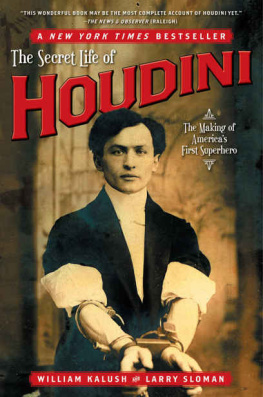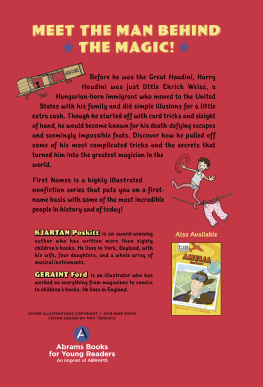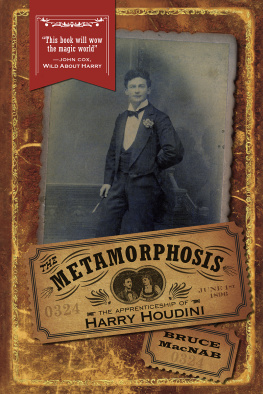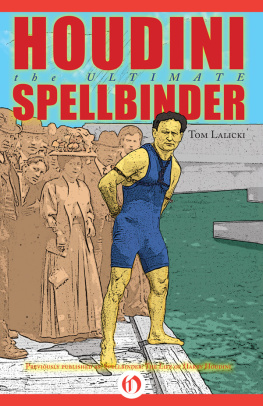Thank you for downloading this Atria Books eBook.
Join our mailing list and get updates on new releases, deals, bonus content and other great books from Atria Books and Simon & Schuster.
C LICK H ERE T O S IGN U P
or visit us online to sign up at
eBookNews.SimonandSchuster.com
The Secret Life of
Houdini

1230 Avenue of the Americas
New York, NY 10020
Copyright 2006 by Light and Heavy, Inc.
All rights reserved, including the right to reproduce this book or portions thereof in any form whatsoever. For information address Atria Books, 1230 Avenue of the Americas, New York, NY 10020
ISBN-13: 978-0-7432-9850-6
ISBN-10: 0-7432-9850-0
ATRIA BOOKS is a trademark of Simon & Schuster, Inc.
Visit us on the World Wide Web:
http://www.SimonSays.com
For three wonderful mothers
Cecilia Weiss, Lilyan Sloman, and Jean Kalush

From the collection of Dr. Bruce Averbook
Table of Contents
Foreword
A S AN AMATEUR MAGICIAN, I FREQUENTLY ask members of an audience to just think of a famous magician. When I ask people to raise their hands if they happen to be thinking of Houdini, inevitably about three-quarters of the hands go upthis despite the fact that Harry Houdini died eighty years ago.
No one would be more pleased with this than Houdini himself, who, as this book illustrates, sought throughout his life to imbed his image in the worlds consciousness. He did this with strenuous feats of daring that fully justify the appellation the authors applyAmericas first superhero.
My own interest in magic ignited when as a child I saw the 1953 movie biography of Houdini, starring Tony Curtis and Janet Leigh. I ran immediately to my local public library and checked out what was then the only full-length biography, Houdini: His Life Story . It was written by Harold Kellock two years after Houdinis death, with the recollections and documents of the magicians wife, Beatrice. It was remarkably thorough for an authorized biography and is still a good read, but it was told, of course, from the perspective of a devoted spouse.
There have been many subsequent biographies, and the better ones have each penetrated a bit deeper below the surface of the Houdini legend. But it is hard to imagine a more difficult subject for biographers than a man who was in his time one of the worlds foremost exponents of secrecy and who was determined to tell the public only those things that burnished his legend. Getting to the essence of the manwhat made him tickhas been an extraordinary and almost always controversial task.
The book you now hold breaks new ground. The evidence the authors have amassed is rich in new detail about many previously charted facets of Houdinis life. More important, though, it opens a tantalizing new possibility: that Houdini might have used his expertisealong with the access his escapes and fame gave him around the worldto advise intelligence and security services in the United Kingdom and the United States, particularly in the years just before World War I. Working with fragmentary new evidence, the authors have put together a plausible case that, as the world headed toward war, there would have been high-level interest in some of what Houdini learned while escaping from various police and security service constraints in places like Germany and Russia and dealing with many of their officials.
Houdini would undoubtedly love the fact that people will now have another set of clues to debate about his mysterious lifeclues that will keep us talking about the Master Mystifier long into the future. In fact, I suspect that a hundred years from now the same large proportion of hands will go up for Houdini when some performer asks the audience to think of a famous magician.
Houdini always said he would do his best to come back from the dead. As far as we know, he has never succeeded. But he would probably regard the endless fascination with his life and legend as the next best thing.
John McLaughlin
Former deputy director and acting director of the Central Intelligence Agency (20002004)
Introduction
H OUDINI DIDNT DIE IN THE WATER torture cell. He didnt have a mother fixation. And he wasnt just a great showman. Eventually, all legends get cluttered by apocryphal stories, and the legend of the greatest professional master of deception is no exception. Much of what has become his story is fabrication. Ironically, the real story is better.
Seven years ago, one of us had an epiphany. It was on April 6, 1999, Houdinis 125th birthday. Bill Kalush was outside of David Blaines first stunt, Buried Alive. Blaine had been buried for a couple of days and since Kalush had planned the stunt with him, he felt it was only right to stand by him all day and night. At about four A.M. , he noticed that some of the same people were coming back each night. They werent friends of the magician or even acquaintances. They were strangers who were somehow compelled to come at all hours to visit a man they didnt know, concerned with his well-being. Somehow they had become emotionally attached to him. In that moment, Bill Kalush understood why we are all interested in Houdini. He, like Blaine after him, compelled us to feel for him and root for him.
A few years later Kalush met writer Larry Sloman. Sloman, a professional writer for most of his life, wrote books on topics as varied as Bob Dylan and ice hockey, and he wrote a major biography of the sixties radical Abbie Hoffman that relied on more than two hundred interviews and years of relentless digging through archival sources. As it happened, Sloman had read all of the major books about Houdini. What struck both of us was that there were huge gaps in Houdinis life story and some puzzling inconsistencies. So we embarked on a journey to discover the real man.
Early on, we discovered an important connection that most biographers had seemed to miss. The young Houdini, though stunningly creative and clever, couldnt make enough money to succeed at magic. Hungry and crestfallen, he was ready to give up his dream, until he walked into a Chicago police station and met a detective who would change his life. Immediately after this fateful encounter, his picture graced the front page of a Chicago newspaper. That picture catapulted him to renown. Within months, he had gone from cheap beer halls and dime museums to the big-timevaudeville. In one years time, he had gone from literally eating rabbits for survival to making what today would equal $45,000 a week. (Throughout the book, for the purposes of comparison, we have converted dollars in Houdinis time to todays values. This is a highly contentious endeavor, but we have relied on the unskilled wage conversion rate provided by www.eh.net, operated by Miami University and Wake Forest University.)
Now came the next mystery. Why would someone who had finally made it big risk everything and leave behind lucrative contracts to go to England with no real prospects in sight? Perhaps what happened to Houdini next answers the question. Within days of arriving in England, Houdini met with a prominent Scotland Yard inspector and once again, his career took off. What was going on, and why hadnt it come to light? In hindsight, Houdini made all the right moves, but at the time, they were wildly risky, even for a man who would come to be known for his death-defying stunts. Did Houdini know something that made sense of these seemingly suicidal career moves?













